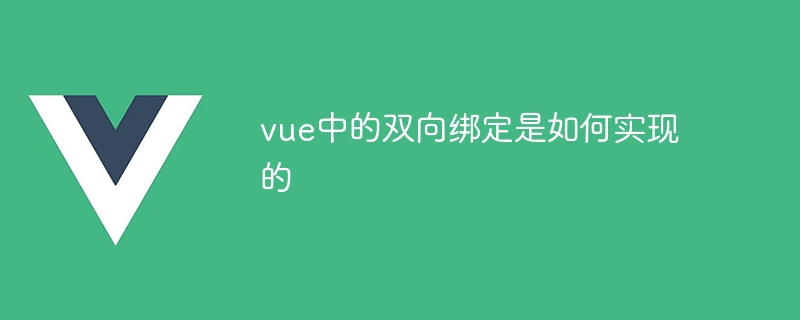How is two-way binding in vue implemented?
Vue’s two-way data binding is implemented through the following steps: the data proxy is wrapped in a reactive proxy and listens for data changes. Data Hijack monitors object properties, detects value changes and triggers updates. Template compilation compiles the data binding syntax into an update function, triggering data changes to update the DOM. Event listening updates model data in response to user interaction and form input. Virtual DOM tracks DOM state, re-renders and applies changes to improve update efficiency. Bidirectional flow combines responsive proxies and virtual DOM to enable mutual updates of data and views.

The implementation principle of two-way data binding in Vue
Vue’s two-way data binding is a convenient and An efficient mechanism that allows data to be kept in sync between views and models. Its implementation mainly involves the following steps:
1. Data proxy
Vue will wrap the data object in a responsive proxy, which will listen for data changes . When data changes, the agent reacts immediately, triggering updates.
2. Data hijacking
Vue uses data hijacking technology to monitor properties in objects. When a property's value changes, Vue detects it and triggers the corresponding update.
3. Template compilation
When Vue parses the template, it compiles the data binding syntax (for example, {{data}}) into an update function. These functions will be triggered when the data changes and update the corresponding DOM elements.
4. Event monitoring
Vue will automatically monitor events such as form input and user interaction. When these events fire, Vue updates the corresponding model data.
5. Virtual DOM
Vue uses virtual DOM to track the state of the DOM. When data changes, Vue re-renders the virtual DOM and then applies the difference to the actual DOM. This greatly improves update efficiency and reduces overhead.
6. Bidirectional flow
The bidirectionality of data binding is achieved by the combination of responsive proxy and virtual DOM. When changes occur in the view, Vue updates the model data; when model data changes, Vue updates the view.
The above is the detailed content of How is two-way binding in vue implemented?. For more information, please follow other related articles on the PHP Chinese website!

Hot AI Tools

Undresser.AI Undress
AI-powered app for creating realistic nude photos

AI Clothes Remover
Online AI tool for removing clothes from photos.

Undress AI Tool
Undress images for free

Clothoff.io
AI clothes remover

Video Face Swap
Swap faces in any video effortlessly with our completely free AI face swap tool!

Hot Article

Hot Tools

Notepad++7.3.1
Easy-to-use and free code editor

SublimeText3 Chinese version
Chinese version, very easy to use

Zend Studio 13.0.1
Powerful PHP integrated development environment

Dreamweaver CS6
Visual web development tools

SublimeText3 Mac version
God-level code editing software (SublimeText3)

Hot Topics
 1664
1664
 14
14
 1421
1421
 52
52
 1315
1315
 25
25
 1266
1266
 29
29
 1239
1239
 24
24
 How to use bootstrap in vue
Apr 07, 2025 pm 11:33 PM
How to use bootstrap in vue
Apr 07, 2025 pm 11:33 PM
Using Bootstrap in Vue.js is divided into five steps: Install Bootstrap. Import Bootstrap in main.js. Use the Bootstrap component directly in the template. Optional: Custom style. Optional: Use plug-ins.
 How to add functions to buttons for vue
Apr 08, 2025 am 08:51 AM
How to add functions to buttons for vue
Apr 08, 2025 am 08:51 AM
You can add a function to the Vue button by binding the button in the HTML template to a method. Define the method and write function logic in the Vue instance.
 How to use watch in vue
Apr 07, 2025 pm 11:36 PM
How to use watch in vue
Apr 07, 2025 pm 11:36 PM
The watch option in Vue.js allows developers to listen for changes in specific data. When the data changes, watch triggers a callback function to perform update views or other tasks. Its configuration options include immediate, which specifies whether to execute a callback immediately, and deep, which specifies whether to recursively listen to changes to objects or arrays.
 What does vue multi-page development mean?
Apr 07, 2025 pm 11:57 PM
What does vue multi-page development mean?
Apr 07, 2025 pm 11:57 PM
Vue multi-page development is a way to build applications using the Vue.js framework, where the application is divided into separate pages: Code Maintenance: Splitting the application into multiple pages can make the code easier to manage and maintain. Modularity: Each page can be used as a separate module for easy reuse and replacement. Simple routing: Navigation between pages can be managed through simple routing configuration. SEO Optimization: Each page has its own URL, which helps SEO.
 How to return to previous page by vue
Apr 07, 2025 pm 11:30 PM
How to return to previous page by vue
Apr 07, 2025 pm 11:30 PM
Vue.js has four methods to return to the previous page: $router.go(-1)$router.back() uses <router-link to="/" component window.history.back(), and the method selection depends on the scene.
 React vs. Vue: Which Framework Does Netflix Use?
Apr 14, 2025 am 12:19 AM
React vs. Vue: Which Framework Does Netflix Use?
Apr 14, 2025 am 12:19 AM
Netflixusesacustomframeworkcalled"Gibbon"builtonReact,notReactorVuedirectly.1)TeamExperience:Choosebasedonfamiliarity.2)ProjectComplexity:Vueforsimplerprojects,Reactforcomplexones.3)CustomizationNeeds:Reactoffersmoreflexibility.4)Ecosystema
 How to reference js file with vue.js
Apr 07, 2025 pm 11:27 PM
How to reference js file with vue.js
Apr 07, 2025 pm 11:27 PM
There are three ways to refer to JS files in Vue.js: directly specify the path using the <script> tag;; dynamic import using the mounted() lifecycle hook; and importing through the Vuex state management library.
 How to use vue traversal
Apr 07, 2025 pm 11:48 PM
How to use vue traversal
Apr 07, 2025 pm 11:48 PM
There are three common methods for Vue.js to traverse arrays and objects: the v-for directive is used to traverse each element and render templates; the v-bind directive can be used with v-for to dynamically set attribute values for each element; and the .map method can convert array elements into new arrays.




